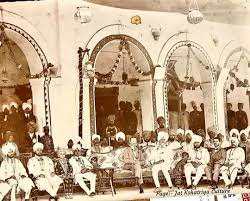Introduction
The Jat community, renowned for its valor, resilience, and significant contributions to Indian history, holds a distinct place among the Kshatriya clans of India. Originating from the fertile lands of the northwestern Indian subcontinent, the Jats have carved a remarkable trajectory through the annals of time, shaping not only their own destiny but also leaving an indelible mark on the socio-political landscape of India.
Unveiling the Pages of History
The book “Jat Kshatriya Itihas” stands as a testament to the profound legacy of the Jat Kshatriyas, meticulously chronicling their journey from ancient times to the present day. Authored by eminent historians and scholars deeply immersed in the cultural tapestry of the Jat community, this book unfolds a narrative that transcends mere historical documentation. It serves as a beacon illuminating the vibrant heritage, turbulent struggles, and enduring spirit of the Jat Kshatriyas across generations.
Understanding the Jat Identity
At the heart of the Jat identity lies a complex interplay of historical narratives, cultural practices, and socio-economic dynamics. The term “Jat” itself encompasses a diverse group of people bound together by a shared ethos of courage, agricultural prowess, and a deep-rooted sense of honor. The evolution of the Jats into recognized Kshatriyas underscores their journey from pastoralists and agriculturists to formidable warriors and rulers in various regions of the Indian subcontinent.
Origins and Early History
The origins of the Jat community trace back to ancient times, primarily in the regions of present-day Haryana, Punjab, Rajasthan, and western Uttar Pradesh. Scholars debate their exact origins, with theories ranging from indigenous roots to Central Asian migrations. Initially, the Jats were predominantly agriculturalists and pastoralists, cultivating the fertile lands along river basins and practicing animal husbandry.
Evolution as Kshatriyas
One of the pivotal transformations in Jat history was their adoption of the Kshatriya identity. The term “Kshatriya” traditionally denotes the warrior and ruling class in Hindu society, associated with valor and leadership. Over centuries, through feats of bravery and military prowess, many Jat leaders and clans earned recognition as Kshatriyas. This transformation elevated their social status and enabled them to establish kingdoms and dynasties across northern India.
Historical Milestones
Throughout history, Jat rulers and chieftains played significant roles in regional politics and governance. The kingdom of Bharatpur, founded by Maharaja Suraj Mal, stands as a testament to their political acumen and military strength. Suraj Mal’s victories against the Mughals and his efforts in consolidating Jat power are emblematic of the Jat spirit of resilience and independence. Similarly, other Jat rulers in Rajasthan, Punjab, and Uttar Pradesh left lasting legacies through their administrative reforms and cultural patronage.
Socio-Cultural Life
The socio-cultural life of the Jat community reflects their agrarian roots and strong kinship bonds. Traditionally, Jats organized themselves into clans or “gotras,” each tracing their lineage to a common ancestor. The institution of “Khap Panchayats” provided governance based on customary laws and norms, emphasizing community solidarity and collective decision-making. Festivals such as Holi, Baisakhi, and Teej hold special significance, celebrating agricultural cycles and communal harmony.
Role in Indian History
During the medieval period, Jats played crucial roles in resisting external invasions and asserting regional autonomy. Their alliances with various rulers and their ability to mobilize large armies made them formidable adversaries. However, their autonomy faced challenges under the British colonial rule, leading to socio-economic changes and agrarian reforms that impacted traditional Jat livelihoods.
Modern Era and Socio-Political Movements
In the 20th century, the Jat community actively participated in India’s freedom struggle and socio-political movements. Leaders such as Chaudhary Charan Singh advocated for agrarian reforms and the rights of farmers, addressing socio-economic disparities and advocating for social justice. The demand for reservation and political representation continues to be a significant aspect of contemporary Jat activism, reflecting ongoing challenges and aspirations within the community.
Cultural Heritage and Identity
Preserving cultural heritage remains a cornerstone of Jat identity. Language, folklore, music, and arts serve as expressions of their rich cultural heritage. The contributions of Jat scholars and intellectuals in literature, historical research, and education have been instrumental in shaping a nuanced understanding of Jat identity beyond stereotypes and misconceptions.
Contemporary Issues and Challenges
In contemporary India, the Jat community grapples with socio-economic disparities, educational attainment, and political representation. Debates surrounding reservation policies, land reforms, and access to resources continue to shape discourse within the community. Globalization and urbanization present new opportunities and challenges, impacting traditional agrarian lifestyles and community cohesion.

Conclusion
In conclusion, the history of Jat Kshatriyas is a saga of resilience, valor, and cultural vibrancy. From their humble origins as farmers and herders to their emergence as formidable warriors and influential rulers, the Jat community has navigated through centuries of change with steadfast determination. The book “Jat Kshatriya Itihas” encapsulates this journey, offering insights into their achievements, challenges, and enduring contributions to Indian civilization. As we reflect on their history, we recognize the enduring legacy of the Jat Kshatriyas and their pivotal role in shaping the diverse tapestry of India’s cultural heritage.
This article provides a comprehensive overview of the history and cultural significance of the Jat Kshatriya community, drawing insights from the book “Jat Kshatriya Itihas” and scholarly research on Jat history.










